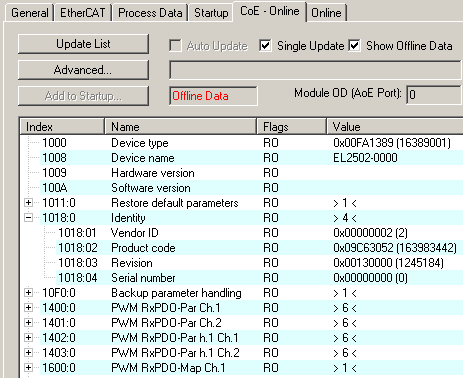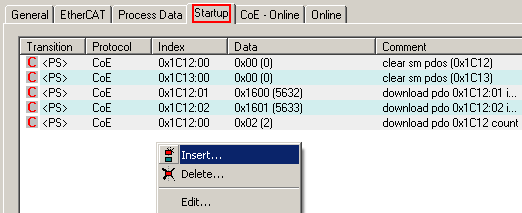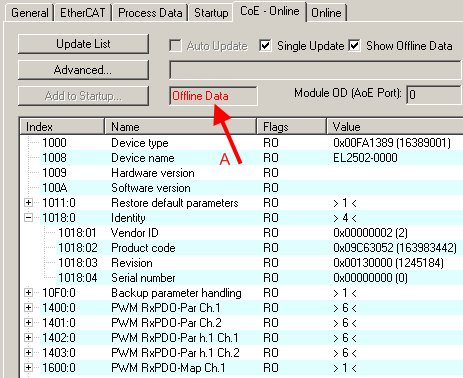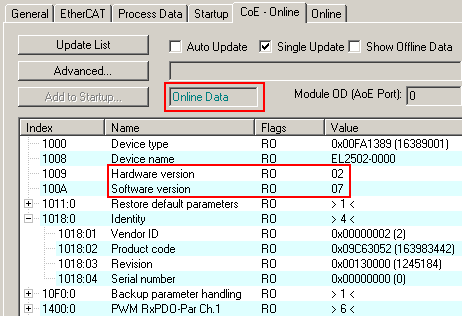CoE interface
General description
The CoE interface (CANopen over EtherCAT) is used for parameter management of EtherCAT devices. EtherCAT slaves or the EtherCAT master manage fixed (read only) or variable parameters which they require for operation, diagnostics or commissioning.
CoE parameters are arranged in a table hierarchy. In principle, the user has read access via the fieldbus. The EtherCAT master (TwinCAT System Manager) can access the local CoE lists of the slaves via EtherCAT in read or write mode, depending on the properties.
Different CoE parameter types are possible, including string (text), integer numbers, Boolean values or larger byte fields. They can be used to describe a wide range of features. Examples of such parameters include manufacturer ID, serial number, process data settings, device name, calibration values for analog measurement or passwords.
Organization takes place on 2 levels by means of hexadecimal numbering: the (main) index is named first, then the subindex. The value ranges are:
- Index 0 to 65535
- Subindex: 0…255
A parameter localized in this way is normally written as x8010:07, with preceding "x" to identify the hexadecimal numerical range and a colon between index and subindex.
The relevant ranges for EtherCAT fieldbus users are:
- x1000: This is where fixed identity information for the device is stored, including name, manufacturer, serial number etc., plus information about the current and available process data configurations.
- x8000: This is where the operational and functional parameters for all channels are stored, such as filter settings or output frequency.
Other important ranges are:
- x4000: In some EtherCAT devices the channel parameters are stored here (as an alternative to the x8000 range).
- x6000: Input PDOs ("input" from the perspective of the EtherCAT master)
- x7000: Output PDOs ("output" from the perspective of the EtherCAT master)
 | Availability Not every EtherCAT device must have a CoE list. Simple I/O modules without dedicated processor usually have no variable parameters and therefore no CoE list. |
If a device has a CoE list, it is shown in the TwinCAT System Manager as a separate tab with a listing of the elements:

The CoE objects from x1000 to x1600, which are available in the example device "EL2502", can be seen in the above figure; the subindices from x1018 are expanded.
Data management
Some parameters, particularly the setting parameters of the slave, are configurable and writeable. This can be done in write or read mode
- via the System Manager (figure above) by clicking. This is useful for commissioning of the system/slaves. Click on the row of the index to be parameterized and enter a value in the SetValue dialog.
- from the control system/PLC via ADS, e.g. through function blocks from the TcEtherCAT.lib library This is recommended for modifications while the system is running or if no System Manager or operating staff are available.
 | Data management If CoE parameters on the slave are changed online, this is saved fail-safe in the device (EEPROM) in Beckhoff devices. This means that the changed CoE parameters are still retained after a restart. The situation may be different with other manufacturers. |
Startup list
 | Startup list Changes in the local CoE list of the terminal are lost if the terminal is replaced. If a terminal is replaced with a new Beckhoff terminal, it will have the factory settings. It is therefore advisable to link all changes in the CoE list of an EtherCAT slave with the Startup list of the slave, which is processed whenever the EtherCAT fieldbus is started. In this way a replacement EtherCAT slave can automatically be parameterized with the specifications of the user. If EtherCAT slaves are used which are unable to store local CoE values permanently, the Startup list must be used. |
Recommended approach for manual modification of CoE parameters
- Make the required change in the System Manager. The values are stored locally in the EtherCAT slave
- If the value is to be stored permanently, enter it in the Startup list. The order of the Startup entries is usually irrelevant.

The Startup list may already contain values that were configured by the System Manager based on the ESI specifications. Additional application-specific entries can be created.
Online/offline directory
While working with the TwinCAT System Manager, a distinction has to be made whether the EtherCAT device is "available", i.e. switched on and linked via EtherCAT and therefore online, or whether a configuration is created offline without connected slaves.
In both cases a CoE directory is visible according to the figure "CoE-Online tab", but the connectivity is displayed as offline/online.
If the slave is offline
- the offline list from the ESI file is displayed. In this case modifications are not meaningful or possible.
- the configured status is shown under Identity
- no firmware or hardware version is displayed, since these are features of the physical device.
- Offline is shown in red

If the slave is online
- the actual current slave directory is read. This may take several seconds, depending on the size and cycle time.
- the actual identity is displayed
- the firmware and hardware version of the equipment according to the electronic information is displayed.
- Online is shown in green

Channel-based order
The CoE directory is located in EtherCAT devices that usually encompass several functionally equivalent channels. e.g. a 4-channel 0 – 10 V analog input terminal also has 4 logical channels and thus 4 identical sets of parameter data for the channels. In order to avoid having to list each channel in the documentation, the placeholder "n" tends to be used for the individual channel numbers.
In the CoE system 16 indices, each with 255 subindices, are generally sufficient for representing all channel parameters. The channel-based order is therefore arranged in 16dec/10hex steps. The parameter range x8000 exemplifies this:
- Channel 0: parameter range x8000:00 ... x800F:255
- Channel 1: parameter range x8010:00 ... x801F:255
- Channel 2: parameter range x8020:00 ... x802F:255
- …
This is generally written as x80n0. Detailed information on the CoE interface can be found in the EtherCAT system documentation on the Beckhoff website.